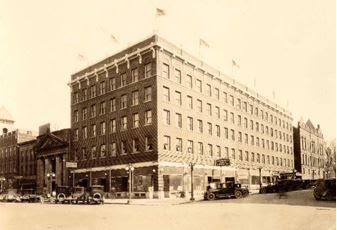Mary Schields was born in
Sandusky
in September, 1862, to Edmund and Salome Schields, both natives of
Germany.
She married George Godfrey about 1893. Mr. Godfrey was born in
England and was a musician with the
Great Western Band. From about 1896 through 1915, Mrs. Mary Schields Godfrey operated a
hat shop at
222 Columbus Avenue.
During some years, she also sold hats at the C. L. Engels Co. store on
Market Street.
Mary and George would often travel to Europe
to purchase hats. An article in the March 25, 1905 issue of the Sandusky Star Journal was entitled “The
Sun Smiled for the Millinery Openings.” Mrs. Godfrey advertised genuine Paris and London
hats, as well as New York Pattern hats for the spring season of 1905.
Mrs. Godfrey published a small catalog of Parisian hats in 1899, which featured models wearing stylish hats, along with
a description of the hats.

Helen Hansen and Virginia Steinemann wrote about hat shops
in Sandusky in
Article 53 of From the Widow's Walk, describing how hats were a very
important fashion necessity for women in the nineteenth century and early
twentieth century. Fourteen separate businesses in Sandusky were listed under millinery in the 1912-1913 Sandusky City
Directory. Miss Yvonne Fievet was an apprentice to Mary Schields Godfrey in the
millinery business. Mrs. Hansen and Mrs. Steinemann spoke with Miss Fievet, and
learned that as an apprentice Yvonne worked three months in the spring and
three months in the fall learning the millinery trade; she received no
wages, but was given a free hat for her six months labor. Miss Fievet went on
to have her own hat shop, from 1929 to 1965. (She had a niece,
also named Yvonne Fievet, who was a longtime librarian at the Sandusky
Library.)


 this blog
this blog


































